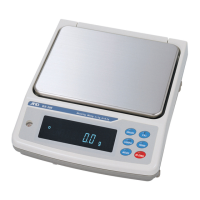What does parameter setting error mean on A&D Scales?
- LlwoodsSep 7, 2025
A parameter setting error on A&D Scales means the received data exceeds the range that the balance can accept. To resolve this, confirm the parameter range of the command.

What does parameter setting error mean on A&D Scales?
A parameter setting error on A&D Scales means the received data exceeds the range that the balance can accept. To resolve this, confirm the parameter range of the command.
What causes automatic response adjustment zero error on A&D Scales?
The automatic response adjustment zero error on A&D Scales indicates that there is something on the pan. Clear the pan and press the CAL key to return to the weighing mode.
What does excess characters error mean on A&D GX-200?
An excess characters error on A&D Scales means the balance received excessive characters in a command. Confirm the command to resolve this issue.
How to resolve undefined command error on A&D Scales?
To resolve an undefined command error on A&D Scales, confirm the command you are trying to execute.
What to do for unit mass error on A&D GX-200?
If you encounter a unit mass error on your A&D Scales, add samples to reach the specified number and then press the PRINT key.
What to do if A&D GX-200 show sample mass error?
If your A&D Scales display a sample mass error, it suggests that the sample is too small. Use a larger sample to resolve this issue.
| Capacity | 210 g |
|---|---|
| Readability | 0.001 g |
| Repeatability (Standard Deviation) | 0.001 g |
| Linearity | ±0.002 g |
| Stabilization Time | Approx. 1.5 seconds |
| Calibration | External calibration |
| Interface | RS-232C |
| Operating Temperature | 5°C to 40°C |
| Display | LCD |
| Power Source | AC adapter |
| Units | g, oz, ozt, ct, dwt, GN, tl |
Describes the manual's structure and purpose.
Lists the key functionalities and benefits of the balance.
Details compliance with FCC rules and EMC directives.
Instructions on how to carefully unpack the balance and its components.
Steps for correctly installing the balance on a stable surface.
Guidelines for proper installation and preparation before initial use.
Precautions and best practices for operating the balance.
Instructions for proper shutdown and care after operation.
Information regarding the AC adapter and power connection.
Describes the balance display symbols and basic key operations.
Lists available weighing units and their conversion factors.
Explains how to select and store units in the function table.
Step-by-step guide for performing basic weighing in gram mode.
Instructions for using the counting mode to determine item count.
Guide for using the percent mode for target weighing.
How to weigh moving objects like animals using the hold function.
How to automatically adjust response and self-check the balance.
How to manually adjust the balance's response settings.
Defines calibration modes and terms used in calibration.
Explains how the balance calibrates automatically with temperature changes.
Procedure for calibrating the balance using its internal weight.
Steps for calibrating the balance with an external weight.
How to test weighing accuracy using an external weight.
Procedure to correct the balance's internal mass value.
How to protect balance parameters by permitting or inhibiting functions.
Procedure to reset balance parameters to factory settings.
Explains the hierarchical structure of the function table menu.
Describes the display symbols and keys used in the function table.
Details parameters for various function table items.
Explains the different data output modes and their settings.
Details various data format options for output.
Explains additional data formats like number, time, date, and ID.
Provides examples of different data output formats.
Procedure to set and confirm the balance's time and date.
How to set up and use the comparator function for weighing.
Procedure for setting a unique ID number for the balance.
How to generate and output Good Laboratory Practice (GLP) reports.
Important notes and procedures for using data memory.
How to store and manage weighing data in memory.
How to store calibration and test data in memory.
How to store unit mass data for counting mode.
Steps to select density mode and input method.
How to set the liquid density or water temperature.
Details the RS-232C interface specifications and pin connections.
Explains the function of external input pins and use examples.
How to connect and set parameters for the AD-8121B printer.
How to connect the balance to a computer via RS-232C.
How to use WinCT software for data communication.
Lists commands for querying data and controlling the balance/memory.
Explains acknowledge codes and error codes received from the balance.
Provides examples of using balance control commands.
Details control using CTS and RTS signals.
Explains settings related to the RS-232C interface.
Steps to check balance performance and operating environment.
Lists and explains various error codes displayed by the balance.
Guidance on contacting for service or repair.
Definitions of key terms used in the manual.
Index of keys, symbols, and their corresponding page numbers.